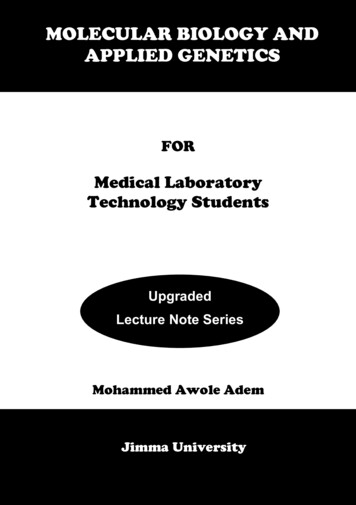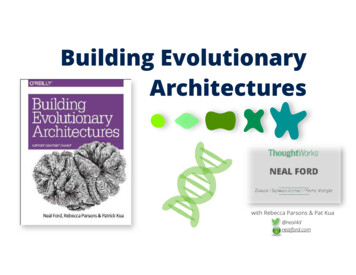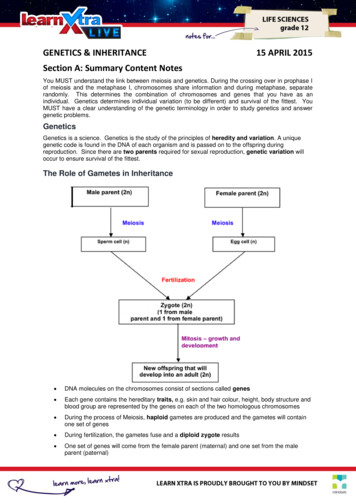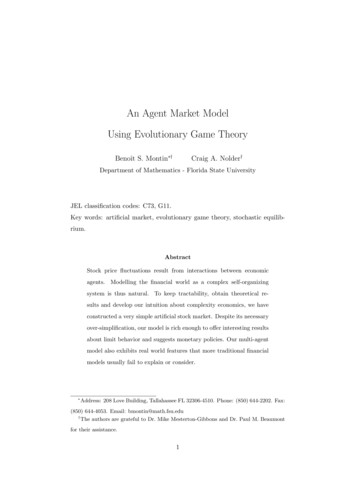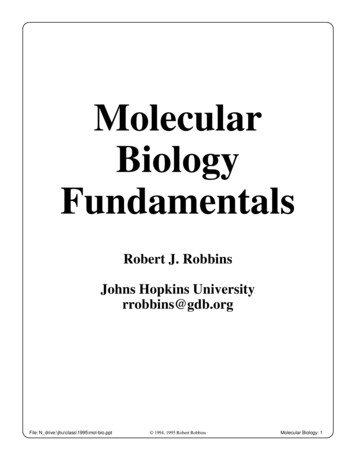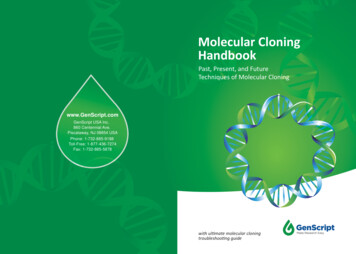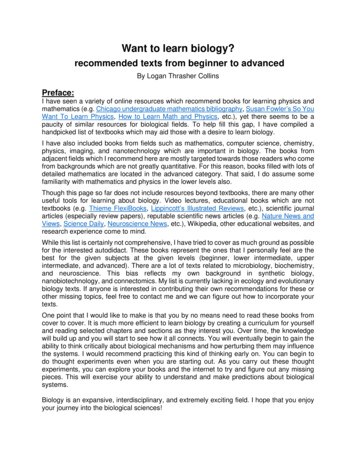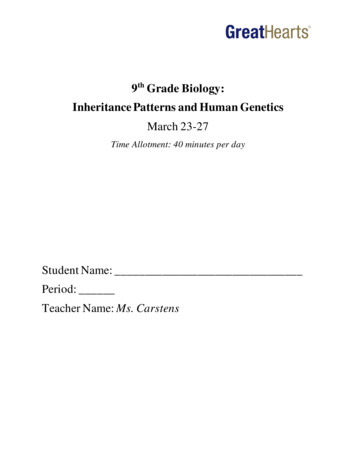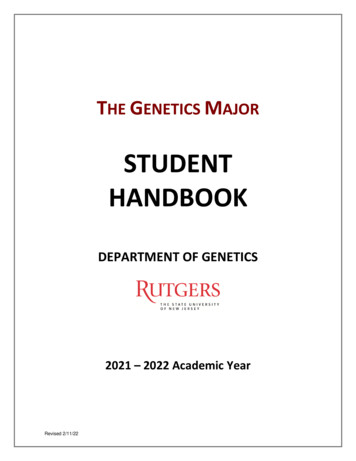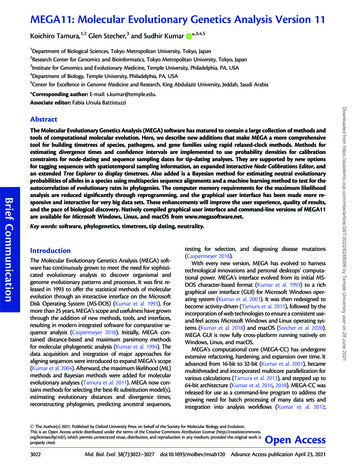
Transcription
MEGA11: Molecular Evolutionary Genetics Analysis Version 11Koichiro Tamura,1,2 Glen Stecher,3 and Sudhir Kumar*,3,4,51Department of Biological Sciences, Tokyo Metropolitan University, Tokyo, JapanResearch Center for Genomics and Bioinformatics, Tokyo Metropolitan University, Tokyo, Japan3Institute for Genomics and Evolutionary Medicine, Temple University, Philadelphia, PA, USA4Department of Biology, Temple University, Philadelphia, PA, USA5Center for Excellence in Genome Medicine and Research, King Abdulaziz University, Jeddah, Saudi Arabia2*Corresponding author: E-mail: s.kumar@temple.edu.Associate editor: Fabia Ursula BattistuzziBrief CommunicationThe Molecular Evolutionary Genetics Analysis (MEGA) software has matured to contain a large collection of methods andtools of computational molecular evolution. Here, we describe new additions that make MEGA a more comprehensivetool for building timetrees of species, pathogens, and gene families using rapid relaxed-clock methods. Methods forestimating divergence times and confidence intervals are implemented to use probability densities for calibrationconstraints for node-dating and sequence sampling dates for tip-dating analyses. They are supported by new optionsfor tagging sequences with spatiotemporal sampling information, an expanded interactive Node Calibrations Editor, andan extended Tree Explorer to display timetrees. Also added is a Bayesian method for estimating neutral evolutionaryprobabilities of alleles in a species using multispecies sequence alignments and a machine learning method to test for theautocorrelation of evolutionary rates in phylogenies. The computer memory requirements for the maximum likelihoodanalysis are reduced significantly through reprogramming, and the graphical user interface has been made more responsive and interactive for very big data sets. These enhancements will improve the user experience, quality of results,and the pace of biological discovery. Natively compiled graphical user interface and command-line versions of MEGA11are available for Microsoft Windows, Linux, and macOS from www.megasoftware.net.Key words: software, phylogenetics, timetrees, tip dating, neutrality.IntroductionThe Molecular Evolutionary Genetics Analysis (MEGA) software has continuously grown to meet the need for sophisticated evolutionary analysis to discover organismal andgenome evolutionary patterns and processes. It was first released in 1993 to offer the statistical methods of molecularevolution through an interactive interface on the MicrosoftDisk Operating System (MS-DOS) (Kumar et al. 1993). Formore than 25 years, MEGA’s scope and usefulness have grownthrough the addition of new methods, tools, and interfaces,resulting in modern integrated software for comparative sequence analysis (Caspermeyer 2018). Initially, MEGA contained distance-based and maximum parsimony methodsfor molecular phylogenetic analysis (Kumar et al. 1994). Thedata acquisition and integration of major approaches foraligning sequences were introduced to expand MEGA’s scope(Kumar et al. 2004). Afterward, the maximum likelihood (ML)methods and Bayesian methods were added for molecularevolutionary analyses (Tamura et al. 2011). MEGA now contains methods for selecting the best-fit substitution model(s),estimating evolutionary distances and divergence times,reconstructing phylogenies, predicting ancestral sequences,testing for selection, and diagnosing disease mutations(Caspermeyer 2018).With every new version, MEGA has evolved to harnesstechnological innovations and personal desktops’ computational power. MEGA’s interface evolved from its initial MSDOS character-based format (Kumar et al. 1993) to a richgraphical user interface (GUI) for Microsoft Windows operating system (Kumar et al. 2001). It was then redesigned tobecome activity-driven (Tamura et al. 2011), followed by theincorporation of web technologies to ensure a consistent useand-feel across Microsoft Windows and Linux operating systems (Kumar et al. 2018) and macOS (Stecher et al. 2020).MEGA GUI is now fully cross-platform running natively onWindows, Linux, and macOS.MEGA’s computational core (MEGA-CC) has undergoneextensive refactoring, hardening, and expansion over time. Itadvanced from 16-bit to 32-bit (Kumar et al. 2001), becamemultithreaded and incorporated multicore parallelization forvarious calculations (Tamura et al. 2013), and stepped up to64-bit architecture (Kumar et al. 2016, 2018). MEGA-CC wasreleased for use as a command-line program to address thegrowing need for batch processing of many data sets andintegration into analysis workflows (Kumar et al. 2012;ß The Author(s) 2021. Published by Oxford University Press on behalf of the Society for Molecular Biology and Evolution.This is an Open Access article distributed under the terms of the Creative Commons Attribution License (http://creativecommons.org/licenses/by/4.0/), which permits unrestricted reuse, distribution, and reproduction in any medium, provided the original work isproperly cited.3022Open AccessMol. Biol. Evol. 38(7):3022–3027 doi:10.1093/molbev/msab120 Advance Access publication April 23, 2021Downloaded from 8099 by Temple University user on 28 June 2021Abstract
MEGA11 . doi:10.1093/molbev/msab120Stecher et al. 2020). With both 32- and 64-bit versions ofMEGA currently available for use on the command-line andGUI, MEGA is now a suite of applications that responds to thevariety of computing environments currently used byresearchers in molecular evolution and phylogenetics. Here,we present key methodological additions and technicalimprovements in MEGA that comprise version 11.Methodological AdditionsExpansion of Relaxed-Clock Dating FacilitiesCalibrating the Clock Using Probability Densities on NodeConstraintsBayesian relaxed-clock methods have long allowed the use ofstatistical probability distributions that capture prior knowledge (or belief) about the true divergence times in clock calibration constraints on one or more nodes in the phylogeny.Judicious use of these probability densities can make divergence times more accurate and precise (Tao, Tamura, Mello,et al. 2020). Researchers can now use such probability densities for node calibrations in RelTime estimation of divergencetimes and confidence intervals (CIs). MEGA implements theTao, Tamura, Mello, et al. (2020) approach that estimates CIsby simultaneously accounting for variance introduced by theheterogeneity of evolutionary rate among lineages, estimationof sequence divergence using substitution models, and probability densities for node-calibration constraints. This methodproduces CIs that contain correct times with a high probability, making them much more suitable for biological hypothesis testing than other rapid methods (Tao, Tamura,Kumar, et al. 2020; Tao, Tamura, Mello, et al. 2020).For RelTime analyses in MEGA11, ML and distance-basedapproaches can be used to build a timetree for a given phylogeny and multiple sequence alignment. One may also useonly a phylogeny with branch lengths, which extends theusefulness of relaxed-clock methods for phylogenies inferredfrom nonmolecular data or statistical methodologies notavailable in MEGA. When a phylogeny with branch lengthsis used, the CIs will be narrower because the variance associated with branch length estimation cannot be generatedwithout the original data set used to produce the phylogenyand branch lengths. Nevertheless, these CIs will incorporatevariance introduced due to rate variation among lineages andclock calibrations’ uncertainty.A calibration density selector has been added to the NodeCalibration Editor that provides an option to select normal,lognormal, uniform, or exponential density (fig. 1). The usercan also specify a minimum or a maximum time bound on anode. The calibration text file format has been extended tospecify density information and use calibration densities inMEGA-CC. The Node Calibration Editor also includes newfunctionality to specify a fixed evolutionary rate or a knownnode time to calibrate the molecular clock. Such assumptionsare often used by investigators when independent calibrationinformation is unknown (Hipsley and Müller 2014; Tao,Tamura, Kumar, et al. 2020).Tip-Dating for Sequences with Sampling TimesMEGA now implements a method to estimate timetrees using sampling dates for molecular sequences. They are oftenused to infer the origin and diversification of pathogens thatgenerally evolve fast enough to track the evolutionary changeover months and years (Tao, Tamura, Kumar, et al. 2020). Tipdating methods are also useful for analyzing ancient molecular sequences. MEGA implements a rapid tip-datingmethod, RelTime with Dated Tips (RTDT), that producesdivergence times and CIs (Miura et al. 2018). One may useML or distance-based approaches for a given phylogeny andmultiple sequence alignment for tip-dating, or a phylogenywith branch lengths and tip dates can be given as the input.An enhanced Timetree Wizard system (fig. 2) walks the userthrough many steps needed to configure tip-dating analyses,such as loading sequence and tree files, specifying the outgroups, adding sequence sample times, and selecting the analysis options. Sequence sampling times can be specified inmultiple ways. MEGA will automatically extract them ondemand when they are included in the sequence name.Spatiotemporal information can also be presented in the inputalignment files as meta tags (see description below) or loadedusing specially formatted calibration text files. Once computed,the timetree is displayed in the Tree Explorer that has beenextensively revamped and updated (fig. 3). It now has manymore formatting tools, including exporting the timetree, individual divergence times, and CI estimates in a tabular format.Detecting Autocorrelation of Evolutionary RatesMEGA now contains a facility for detecting autocorrelation ofevolutionary rates among branches, which is important forunderstanding molecular evolution patterns and useful as aclock rate prior in Bayesian relaxed-clock analyses. MEGAimplements the CorrTest method developed using machinelearning, which is accurate and computationally efficient (Taoet al. 2019). The CorrTest implementation in MEGA requiresa phylogeny with sequence alignment (or branch lengths)and is accessed through an easy-to-use wizard. This test’s finaloutput is a CorrScore between 0 and 1 and a P-value, where ahigh CorrScore and low P-value indicates that branch ratesamong lineages are likely correlated.Calculating Neutral Evolutionary ProbabilitiesAccording to the neutral theory of molecular evolution, mostdifferences in molecular sequences across species are expected3023Downloaded from 8099 by Temple University user on 28 June 2021Rapid relaxed-clock methods for estimating divergence timesare becoming popular because they are feasible and efficientfor large contemporary sequence alignments (Tao, Tamura,Kumar, et al. 2020). MEGA6 first added methods and tools forconstructing evolutionary timetrees by implementing theRelTime method, which does not assume a molecular clock(Tamura et al. 2012, 2013). RelTime is known to perform welland has been used to build timetrees in hundreds of researcharticles (Tao, Tamura, Kumar, et al. 2020). MEGA11 expandson RelTime dating options by advancing the current implementation and adding new facilities for node-dating and tipdating needed to build timetrees of pathogens, species, andgene families.MBE
MBETamura et al. . doi:10.1093/molbev/msab120to have little to no impact on fitness (Kimura 1983). Therefore,multispecies sequence alignments have been used to estimateneutral evolutionary probabilities (EP) of observing alternativealleles (amino acid residues or nucleotides) in a species, contingent on the given species timetree (Liu et al. 2016). MEGAimplements an advanced option for this Bayesian approach inwhich the species timetree containing relative times is computed automatically by using RelTime (Patel and Kumar2019). Alleles with EP less than 0.05 are nonneutral, whereasevolutionary permissible (neutral) alleles show much higherEPs. Disease-associated amino acid variants in human populations have EP 0.05 and are rarely found in the population(Liu et al. 2016). Many human adaptive variants in populationsalso have low EPs, that is, nonneutral from an evolutionaryperspective, but they show high allele frequencies (Patel et al.2018). Therefore, one may use EPs to diagnose disease mutations and detect candidate adaptive variants. An EP wizardsystem walks the user through the steps required to set up theanalysis. The first sequence in the alignment is used automatically as the focal taxon of interest (one can rearrange sequences in the Sequence Data Explorer). EP values for all possiblebases (4 for nucleotides and 20 for amino acids) at each position in the input sequence alignment are reported in aspreadsheet or text format.3024Technological AdvancesAlthough some new user interface elements have alreadybeen mentioned above (figs. 1–3), additional technical advances in MEGA11 are as follows.Expanded Group DesignationsMEGA has long supported a “group” tag for sequences andother operational taxonomic units (OTUs). Using the sequence“group” tags, MEGA offered a group-wise exploration of inputdata, selection of data subsets, and computational analyses(Kumar 2001). Support for two new tags (“population” and“species”) was added in MEGA7, with the species tags used tomark duplicate genes in multigene family phylogenies (Kumaret al. 2016). In MEGA11, sequences can now be tagged toprovide information on the continent, country, city, year,month, day, and time. This spatiotemporal information canbe used in tip-dating analyses.In MEGA11, we have made a MEGA-wide change to useany meta tag to define groups. For example, if one selects the“Year” meta tag for use as a group, they could estimate average diversity within and between sequences sampled indifferent years (Distance menu). In the Sequence DataExplorer, one can select/unselect sequences of certain yearsDownloaded from 8099 by Temple University user on 28 June 2021FIG. 1. Calibration points for MEGA’S RelTime method are chosen in the Node Calibration Editor window (A), accessed via the Timetree Wizardsystem (see fig. 2A). The Node Calibration Editor displays the phylogeny where individual node calibrations and probability densities can be chosenby clicking the calibration button on the top toolbar for the selected node. A dropdown menu (B) with several calibration density types isdisplayed. The Node Calibration Editor then prompts the user for required distribution parameters, depending on the distribution selected: normaldistribution (mean and standard deviation), lognormal (offset, mean and standard deviation), exponential (offset and decay parameter), uniform(min and max) (C).
MEGA11 . doi:10.1093/molbev/msab120MBEfor phylogenetic analyses. Also, the display of years would beautomatically enabled in the Tree Explorer, and the feature tocollapse sequence clusters will be done by years. Additionally,sequences can be sorted based on years in all the input dataand result explorer displays. Therefore, a dynamic designationof groups based on the desired meta tag will enable dataexploration and analysis more efficiently.configurations have the same likelihood value. The totallog-likelihood is simply the sum of site-configuration log-likelihoods weighted by their frequencies. However, this upgraderequired refactoring many different parts of MEGA’s calculation engine, including functions for phylogeny constructionand model selection.Enhanced GUI for Exploring Large Data SetsMemory Efficient ML AnalysesML methods are widely used for phylogenetic inference butplace high demands on computer memory, becoming increasingly burdensome for bigger sequence alignmentsanalyzed these days. In MEGA11, we have now completeda long-overdue refactoring of ML calculations by adding astep to identify common site configurations, that is, siteswhere all sequences have the same bases as at some othersites, to utilize computer memory more efficiently. The memory requirements of Maximum Likelihood and Maximumparsimony analysis are reduced (approximately) by the factorof m/L when there are m distinct site configurations in asequence alignment containing L sites. The memory savingcan be substantial for multigene and genome-scale alignments. For example, the memory saving was 660 MB (209vs. 870 MB) for a sequence alignment of 229 birds with 2,728sites (Claramunt and Cracraft 2015) and 4.5 GB (2.3 vs.6.8 GB) for an alignment of 162 mammals with 11,010sites (Meredith et al. 2011). This memory saving does nothave any detrimental impact on phylogenetic estimatesand computational times because identical siteUsing a large multiple sequence alignment containing 68,000genomes and 30,000 bases each, we assessed MEGA GUI’sresponsiveness during input data file reading, execution offunctions in the Sequence Data Explorer, estimation of pairwise distances, and building of distance-based phylogenies.We found the GUI to become intermittently unresponsivefor such large data sets, which are now common dueto resequencing and population sequencing efforts.Consequently, we have moved all potentially long-runningoperations out of the main GUI thread to backgroundthreads in a major overhaul of the source code. Now, largeinput data files are read rapidly, and calculations of pairwisedistance matrices, selection tests, and phylogeny constructionfor distance-based methods are performed in a backgroundthread. The Sequence Data Explorer has been reprogrammedto enable more efficient highlighting of variable sites, andnavigation of the sequence alignment has been improved.Also added are options to automatically label sites basedon attributes, which annotates sites by providing a onecharacter label and then using desired labeled sites to subsetdata for any molecular phylogenetic analysis desired.3025Downloaded from 8099 by Temple University user on 28 June 2021FIG. 2. The Tip Dating Wizard (A) guides the user through the steps required to set up the RTDT analysis. Once a sequence alignment and/or a treeis provided, the user is prompted to specify the outgroup by selecting a node in the Tree Explorer or specifying outgroup taxa by name (not shown).Next, sample times are specified using the Tip Dates Editor (B) with facilities for parsing tip dates (C) encoded in taxa names, importing tip datesfrom a text file, and manually entering the dates. In the next step, the Analysis Preferences dialog (not shown) is displayed, allowing the user to setanalysis options to estimate branch lengths used by RTDT. The estimated timetree is displayed in the Tree Explorer (see fig. 3).
MBETamura et al. . doi:10.1093/molbev/msab120ConclusionsVersion 11 of MEGA adds many methods and tools to keeppace with researchers’ growing needs. The addition of evolutionary dating methods in MEGA make it easier to estimatespecies and strain divergence times by using more informativenode calibrations and sampling times. The new CorrTest andEP calculations will enable a more robust evaluation ofassumptions about biological characteristics of moleculardata. The reduction in memory needs of ML-based computations will allow users to analyze much larger data sets thanbefore. The refactoring of distance-based methods’ calculation to run in threads independent of the main graphicalinterface and other GUI enhancements greatly improveMEGA usability for very large data sets.AcknowledgmentsWe thank our laboratory members and many beta testers forproviding invaluable feedback and bug reports. This study3026was supported in part by research grants from the NationalInstitutes of Health (R35GM139504-01), National ScienceFoundation (DEB-2034228, DBI-1661218), and Japan Societyfor the Promotion of Science (JSPS) grants-in-aid for scientificresearch (DB5) to K.T.Data AvailabilityThe software and its source code are available from www.megasoftware.net.ReferencesCaspermeyer J. 2018. MEGA software celebrates silver anniversary. MolBiol Evol. 35(6):1558–1560.Claramunt S, Cracraft J. 2015. A new time tree reveals Earth history’simprint on the evolution of modern birds. Sci Adv. 1(11):e1501005.Hipsley CA, Müller J. 2014. Beyond fossil calibrations: realities of molecular clock practices in evolutionary biology. Front Genet. 5:138.Kimura M. 1983. The neutral theory of molecular evolution. New York:Cambridge University Press.Downloaded from 8099 by Temple University user on 28 June 2021FIG. 3. MEGA’s Tree Explorer (A) is a feature-rich, versatile viewer of phylogenies that provides many interactive exploration and customizationfacilities. In MEGA11, the new side toolbar of Tree Explorer makes formatting, rearrangement, and tree exploration tools more accessible andintuitive. Instead of a thin toolbar with nameless buttons, we have opted for a wide toolbar with text labels identifying each tool. The toolbar can bemoved to either side of the window, and it can be toggled in and out of view. To organize related tools by groups and accommodate limited verticalspace, collapsible panels are used. With the new toolbar, formatting tools previously displayed in external dialogs are readily accessible, and formatsare applied instantly instead of after the user closes the external dialog. In addition to the updated toolbar, there are now options for autocollapsing of nodes containing clusters of taxa belonging to the same group, user-specified cluster size, or by the branch length difference. For verylarge trees with many similar sequences, this feature can greatly facilitate the visualization of evolutionary events at a glance. An option has beenadded to export pairwise patristic distances between taxa to a text file for phylogenies and timetrees. For maximum likelihood and maximumparsimony trees where ancestral sequences are present, an option has been added to navigate through sites where a change in the estimatedancestral state differs between the parent and child on the currently selected branch. The tree information box (B) has been updated for timetreesto show branch- and node-specific information, such as earliest and latest sample times in the currently selected subtree, days elapsed between thedivergence time for a selected node and the latest sample time, the nearest and furthest tip from a selected node, clade size and clade taxa, andspatiotemporal information if available.
MEGA11 . doi:10.1093/molbev/msab120Miura S, Tamura K, Tao Q, Huuki LA, Pond SLK, Priest J, Deng J, Kumar S.2018. A new method for inferring timetrees from temporally sampled molecular sequences. PLoS Comput Biol. 16:24.Patel R, Kumar S. 2019. On estimating evolutionary probabilities of population variants. BMC Evol Biol. 19(1):133 (14 pp.).Patel R, Scheinfeldt LB, Sanderford MD, Lanham TR, Tamura K, Platt A,Glicksberg BS, Xu K, Dudley JT, Kumar S. 2018. Adaptive landscape ofprotein variation in human exomes. Mol Biol Evol. 35(8):2015–2025.Stecher G, Tamura K, Kumar S. 2020. Molecular Evolutionary GeneticsAnalysis (MEGA) for macOS. Mol Biol Evol. 37(4):1237–1239.Tamura K, Battistuzzi FU, Billing-Ross P, Murillo O, Filipski A, Kumar S.2012. Estimating divergence times in large molecular phylogenies.Proc Natl Acad Sci USA. 109(47):19333–19338.Tamura K, Peterson D, Peterson N, Stecher G, Nei M, Kumar S. 2011.MEGA5: molecular evolutionary genetic analysis using maximumlikelihood, evolutionary distance, and maximum parsimony methods. Mol Biol Evol. 28(10):2731–2739.Tamura K, Stecher G, Peterson D, Filipski A, Kumar S. 2013. MEGA6:molecular evolutionary genetics analysis version 6.0. Mol Biol Evol.30(12):2725–2729.Tao Q, Tamura K, Battistuzzi F, Kumar S. 2019. A machine learningmethod for detecting autocorrelation of evolutionary rates in largephylogenies. Mol Biol Evol. 36(4):811–824.Tao Q, Tamura K, Kumar S. 2020. Efficient methods for dating evolutionary divergences. In: Ho SYW, editor. The molecular evolutionaryclock. Switzerland: Springer Nature. p. 197–219.Tao Q, Tamura K, Mello B, Kumar S. 2020. Reliable confidence intervalsfor RelTime estimates of evolutionary divergence times. Mol BiolEvol. 37(1):280–290.3027Downloaded from 8099 by Temple University user on 28 June 2021Kumar S, Stecher G, Li M, Knyaz C, Tamura K. 2018. MEGA X: molecularEvolutionary Genetics Analysis across computing platforms. Mol BiolEvol. 35(6):1547–1549.Kumar S, Stecher G, Peterson D, Tamura K. 2012. MEGA-CC: computing core of molecular evolutionary genetics analysis programfor automated and iterative data analysis. Bioinformatics28(20):2685–2686.Kumar S, Stecher G, Tamura K. 2016. MEGA7: molecular EvolutionaryGenetics Analysis version 7.0 for bigger datasets. Mol Biol Evol.33(7):1870–1874.Kumar S, Tamura K, Jakobsen I, Nei M. 2001. MEGA2: molecularevolutionary genetics analysis software. Bioinformatics17(12):1244–1245.Kumar S, Tamura K, Nei M. 1993. MEGA: Molecular EvolutionaryGenetics Analysis version 1.01. University Park (PA): ThePennsylvania State University.Kumar S, Tamura K, Nei M. 1994. MEGA—molecular evolutionary genetics analysis software for microcomputers. Comput Appl Biosci.10(2):189–191.Kumar S, Tamura K, Nei M. 2004. MEGA3: integrated software forMolecular Evolutionary Genetics Analysis and sequence alignment.Brief Bioinform. 5(2):150–163.Liu L, Tamura K, Sanderford MD, Gray V, Kumar S. 2016. A molecularevolutionary reference or the human variome. Mol Biol Evol.33(1):245–254.Meredith RW, Jane cka JE, Gatesy J, Ryder OA, Fisher CA, Teeling EC,Goodbla A, Eizirik E, Sim ao TLL, Stadler T, et al. 2011. Impacts of thecretaceous terrestrial revolution and KPg extinction on mammaldiversification. Science 334(6055):521–524.MBE
articles (Tao, Tamura, Kumar, et al. 2020 ). MEGA11 expands on RelTime dating options by advancing the current imple-mentation and adding new facilities for node-dating and tip-dating needed to build timetrees of pathogens, species, and gene families. Calibrating
